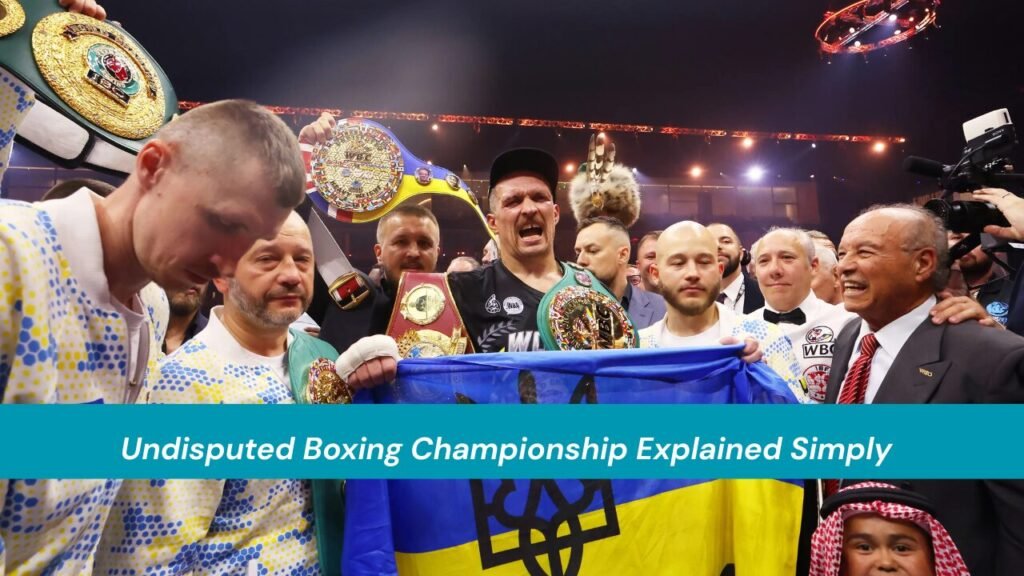The undisputed boxing championship is one of the rarest and most prestigious accomplishments in the sport. It represents the moment when a single fighter stands atop a division, holding all major world titles at the same time. In an era when multiple sanctioning bodies crown their own champions, the title of “undisputed” eliminates all doubt about who is truly the best in a weight class. For boxing fans, it provides clarity in a sport often clouded by politics, promotions, and fragmented belts. For fighters, it cements a place in history alongside the legends of the game.
In this comprehensive guide, we will explore the origins of the undisputed championship, the criteria and challenges for earning it, the most notable champions of the past and present, and the future of this highly coveted status in the sport.
Understanding the Meaning of the Undisputed Boxing Championship
To be recognized as an undisputed champion, a boxer must hold all major recognized world titles in their weight division at the same time. Today, there are four primary sanctioning bodies in professional boxing: the World Boxing Association (WBA), the World Boxing Council (WBC), the International Boxing Federation (IBF), and the World Boxing Organization (WBO). Each of these organizations awards its own championship belt, and each has its own rankings, rules, and mandatory challengers.
When a fighter manages to collect the WBA, WBC, IBF, and WBO belts, they become the sole, universally recognized champion of that division. This is a significant achievement because it requires defeating other top champions from different sanctioning bodies, something that often involves overcoming not only physical challenges in the ring but also the business and political barriers of the sport.
A Brief History of the Undisputed Title in Boxing
The concept of an undisputed champion predates the multiple-belt era. In boxing’s earlier decades, there was generally only one champion per division, so the title of “world champion” automatically implied undisputed status. Fighters like Jack Johnson, Joe Louis, and Sugar Ray Robinson were recognized as the single, clear rulers of their respective weight classes.
The picture began to change in the mid-20th century when different governing bodies emerged. Initially, the WBA and WBC were the primary organizations, and a boxer had to hold both belts to be considered undisputed. Later, the IBF, established in 1983, and the WBO, founded in 1988, joined the fold. By the early 2000s, consensus in the sport dictated that a fighter must hold all four belts to be regarded as the undisputed champion.
Over time, this raised the bar for boxers seeking undisputed glory. Before the WBO gained full recognition, undisputed champions such as Marvin Hagler and Mike Tyson unified three belts. Tyson’s run in the late 1980s, when he defeated Trevor Berbick, James “Bonecrusher” Smith, and Tony Tucker to collect the WBC, WBA, and IBF titles, remains one of the most famous unification campaigns in history. In the modern era, champions like Bernard Hopkins, Oleksandr Usyk, and Terence Crawford have cemented their legacies by completing the four-belt sweep.
The Criteria for Becoming Undisputed
Earning the undisputed title is no simple feat. The journey begins with winning at least one major world championship and then pursuing unification bouts against other titleholders. This often means stepping into the ring with fighters who are not only the best in the world but who also bring very different fighting styles.
Once a boxer starts collecting belts, they must defend them successfully while continuing to unify with other champions. Failure to defend against mandatory challengers can result in a sanctioning body stripping a title, which would end the undisputed reign. This is why timing is crucial. Champions must navigate a delicate balance between satisfying the demands of sanctioning bodies, keeping promoters aligned, and ensuring they stay active enough to maintain all titles simultaneously.
For example, Terence Crawford’s rise to undisputed status in the junior welterweight division required a precise series of victories over champions from multiple organizations. Years later, his accomplishment at welterweight proved that not only can a fighter achieve undisputed status once, but with skill, discipline, and strategic matchmaking, they can do it in multiple weight classes, an incredibly rare achievement.
Why the Undisputed Title Is So Significant
The undisputed championship has both symbolic and practical significance. Symbolically, it represents total dominance in a division. It signals that the champion is without question the number one fighter at that weight, regardless of organization or promotional alignment. This clarity is something boxing fans crave, especially in a sport that can sometimes be fractured by competing interests.
Practically, holding all belts can dramatically increase a fighter’s marketability and earning power. Undisputed champions often command higher purses, attract more sponsorship deals, and gain greater leverage in negotiating future bouts. It also enhances a fighter’s legacy, as historians and fans tend to view undisputed champions as belonging to an elite class. Being undisputed can be the deciding factor in Hall of Fame consideration and can influence a fighter’s place in all-time rankings.
Current Undisputed Champions in Men’s and Women’s Boxing
As of 2025, a small but notable group of fighters hold or have recently held undisputed status. In men’s boxing, Terence Crawford’s dominance at welterweight, Jermell Charlo’s reign at super welterweight, and Devin Haney’s run at lightweight stand out. Crawford, in particular, has garnered praise for achieving undisputed status in two weight divisions during the four-belt era a feat no other male fighter has accomplished.
In women’s boxing, undisputed champions have become more common due in part to increased cooperation between promoters and the growing popularity of the sport. Claressa Shields has established herself as a two-division undisputed champion, unifying both the middleweight and light middleweight divisions. Katie Taylor’s dominance at lightweight and Amanda Serrano’s reign at featherweight have further highlighted the high skill level and marketability of women’s boxing at the elite level.
The Challenges Along the Path to Undisputed Status
The journey to becoming an undisputed champion is fraught with obstacles beyond the ring. One of the biggest challenges is the rivalry between different promoters and networks. Boxing’s promotional landscape is divided among major players, and each promoter seeks to protect their fighters and their business interests. Negotiating cross-promotional fights can be as difficult as the bouts themselves.
Mandatory defenses imposed by sanctioning bodies are another hurdle. Each organization has its own top-ranked challengers, and if a champion refuses to fight a mandatory opponent in favor of a unification bout, they risk losing a title outside the ring. Additionally, fighters must manage the physical and mental toll of frequent high-level competition. Injuries, training setbacks, or even changes in weight class can derail an undisputed campaign.
These challenges are why periods of undisputed dominance are often short-lived. Even after achieving the goal, champions may vacate belts to move up in weight, avoid tough mandatory defenses, or chase bigger paydays elsewhere.
Legendary Undisputed Fights That Defined Eras
Throughout boxing history, certain undisputed fights have captured the world’s attention and become iconic moments. In 1999, Lennox Lewis and Evander Holyfield met for the second time in a heavyweight rematch that unified the division and solidified Lewis’s place as the best heavyweight of his era. Bernard Hopkins’s 2004 knockout victory over Oscar De La Hoya unified the middleweight titles and showcased his tactical brilliance.
More recently, Oleksandr Usyk’s victory over Anthony Joshua in 2021, while not for undisputed status, set the stage for a potential undisputed heavyweight clash with Tyson Fury. In the women’s game, Katie Taylor’s 2019 victory over Delfine Persoon was a grueling battle that cemented her status as the undisputed lightweight queen.
These bouts are remembered not just for the belts at stake, but for the high level of competition and the historical implications of the results.
The Future of the Undisputed Boxing Championship
The modern boxing landscape has seen an increase in undisputed champions compared to previous decades, thanks in part to fan demand and improved cooperation among certain promoters. Social media has played a role as well, with fans rallying online to pressure sanctioning bodies and promoters into making unification bouts happen.
Looking ahead, the prestige of the undisputed title is unlikely to fade. In fact, as the sport becomes more globalized, the title may gain even more significance, serving as a unifying symbol for fans across different markets. The challenge will remain the same: aligning the schedules, business interests, and physical readiness of the world’s top fighters to make these historic matchups a reality.
Conclusion
The undisputed boxing championship stands as the ultimate accomplishment in the sport. It is a rare and precious achievement that requires not only elite skill and dedication but also the ability to navigate the complex business and political realities of professional boxing. Whether it is Terence Crawford carving his name into history books, Claressa Shields redefining women’s boxing, or future stars chasing glory, the undisputed crown will always be a symbol of unmatched dominance and legacy.
For those who follow boxing closely, the road to undisputed is one of the sport’s most thrilling narratives, a journey that blends the drama of the ring with the intrigue of negotiations, rivalries, and personal ambition. As long as there are belts to unify and champions to challenge, the dream of becoming undisputed will continue to inspire fighters and captivate fans around the world.
FAQs
What is the difference between undisputed and unified champions?
A unified champion holds two or more belts, but not all four. An undisputed champion holds all four recognized belts in their weight class.
How long can a boxer stay undisputed?
As long as they keep defending all four belts without losing or being stripped due to mandatory defense obligations.
Can there be multiple undisputed champions at the same time?
Yes, but only if they are in different weight classes.




